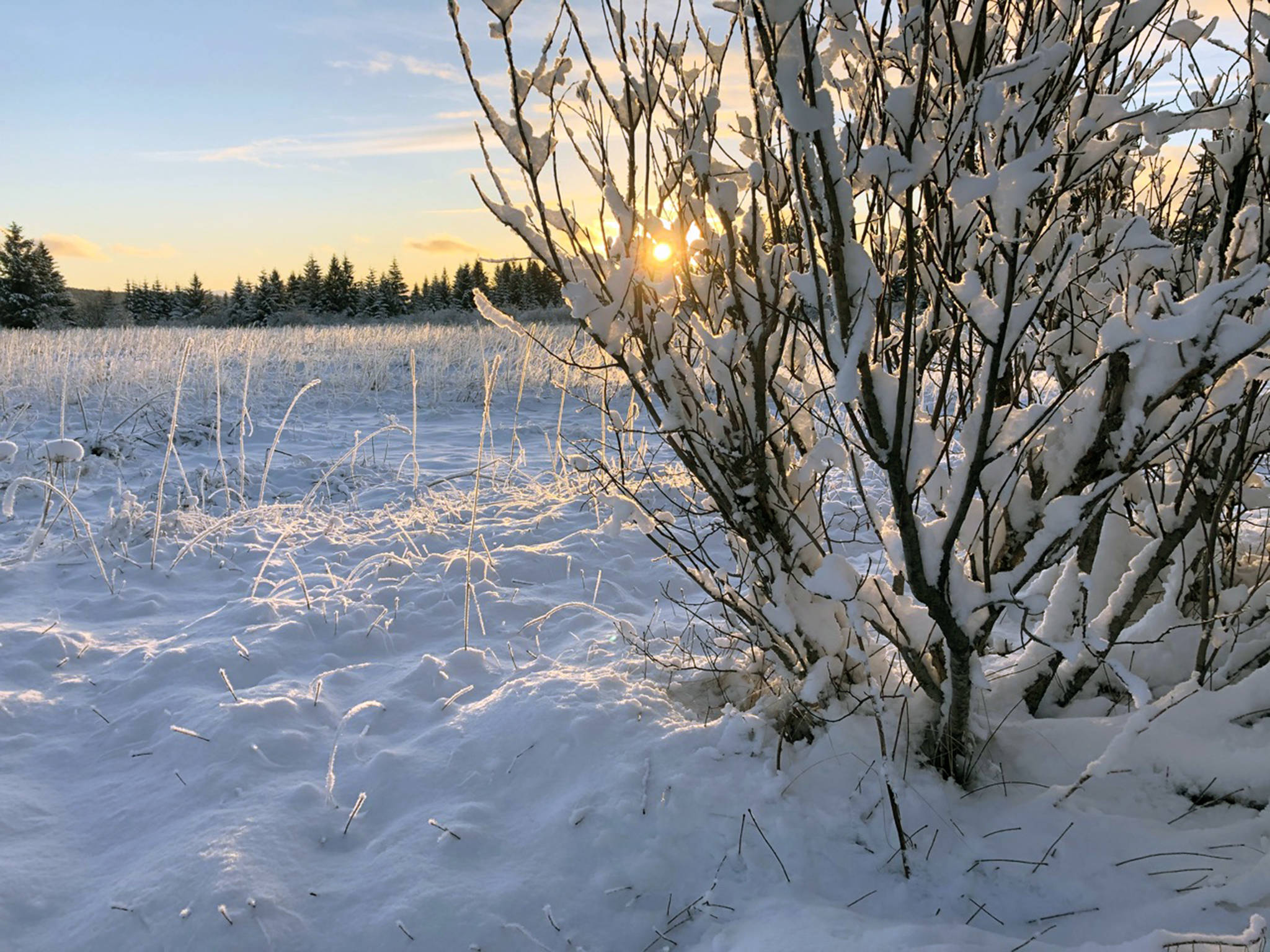The day began in quiet leisure — in a comfortable chair with a cup of hot tea, looking out a big window on a snowy field and waiting for birds to arrive at a seed-feeder. Soon, a crowd of juncos was having breakfast, milling about on a ground-level spread of seeds. The cat at my feet liked the juncos too, especially the ones just a few inches from the window.
An occasional chickadee flitted through, snatching a sunflower seed on the way. The sharp-shinned hawk that had tried for a feeding junco the previous day did not show up on this morning, so all was peaceful under the little arbor that kept snow off the feeder, except for minor altercations among the juncos themselves. Flared tail feathers and open beaks led to some jostling about. One junco with a gimpy leg held its own with the others.
The sun peeked through the trees, and it was time to go for a walk. Just outside the door, we found a perfect miniature snow-angel, where a junco had touched down and spread its wings for a quick flit to the feeder.
Walking through the woods on the way to the beach, the only “wildlife” we saw was a spider dangling on a long silk thread and a “looper”-type of caterpillar, seemingly frozen solid but able to squirm when warmed in a hand.
A flight of pine siskins, over a hundred of them, swarmed by, overhead. Crossbills called in some of the spruces and left wings of spruce seeds on the snow. There are subtle distinctions among the red crossbills, based on calls and bill size. Usually, we have the hemlock (small bill) and spruce (medium bill) types, but recently the douglas-fir type (also a medium bill size but a different call) has been reported here, north of its usual range in the Pacific Northwest.
The grasses on the upper meadows made beautiful golden, frost-covered arches that caught the sunlight. A snipe was foraging in a nearby ditch. It was mostly concealed by the steep bank but occasionally it flew ahead to find a new spot in which to search. Although they typically nest in marshy places, in fall and winter we see them on forested streams. There were clusters of mallards at the edge of the river, foraging and sleeping. Small gangs of geese flew noisily overhead.
At the edge of the estuary, an otter had emerged and left a typical trail of footprints interrupted by a long, smooth slide. A raven had hopped up from the water’s edge and gone airborne, leaving the marks of jumping feet and just one wing. Perhaps it veered off to the side as it took off. A very small shorebird had left its prints in the mud. The snow on the high intertidal area was smooth and unmarked; no wolves or moose had passed by there recently.
Heading back toward the forest, the scattered, pioneering spruces gradually got denser and taller. From behind one small stand, a large bird went winging, almost overhead, into a bigger stand of taller spruces. Aha! A short-eared owl, a hoped-for sighting. These owls often frequent the meadows in winter, looking for voles and other small, vulnerable critters. They are fun to watch, with their distinctive style of flight.
Some crossbills landed on small spruces; they occasionally chose a vertical twig and perched right at the end of it. This led to the question of how they manage to perch there without getting stabbed by the sharp needles. Can they just somehow fit their toes among the erect needles? Or do they perhaps select twigs that have a large central, unopened bud to wrap their toes around?
Near one spruce grove, we stopped to look at something (now forgotten) and I heard an odd sound coming from the trees. It was hard to describe — I heard it as a soft, tonal “pop,” but my companion described it as a moan or wheeze. There were several of these pops, and my naturalist friend said they were made by a red squirrel. Really? Yup — they do it after each sharp, little bark, perhaps when inhaling. I couldn’t hear the barks, just the pops, but my friend saw the squirrel in the tree and was confident that it was the perpetrator. A new thing to listen for!
Back to the house to dig through a treasure box of animal bones and wonder about them. Both bats and birds fly, but birds have a big keel on the sternum (breastbone) and bats don’t. Why is the sternum of mice and squirrels so extremely narrow but that of deer is proportionately more substantial? The lower jaw of fox and skunk has a tiny, seemingly functionless last molar that does not occlude with teeth on the upper jaw.
The first cervical vertebra of mammals holds up the skull; it’s called the atlas, a name from Greek mythology. Atlas was on the losing side of a battle and was condemned to hold up the skies on his shoulders (although he was usually depicted as holding up the world). The atlases of bears and cats have wide, rounded lateral wing-like expansions, but those of moose and deer have narrower, straighter flanges. Many questions; I need a convenient functional morphologist for answers!
• Mary F. Willson is a retired professor of ecology. “On The Trails” is a weekly column that appears every Wednesday.

